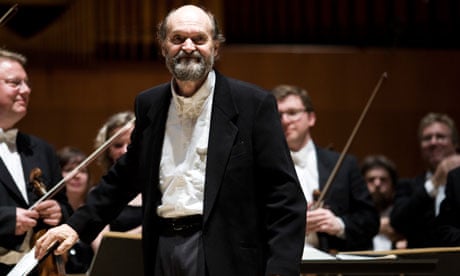Arvo Pärt is one of those composers you might think you know: a reclusive, extravagantly bearded Estonian who's ensconced in a world of so-called "holy minimalism" – a reverie of simplicity that luxuriates in the pure sounds of "tintinnabulatory" tonality, which sounds a corrective (for some) and sentimental (for others) note of archaism in a world of chaotic modernity. (Don't worry; I'll come back to the whole "tintinnabulation" thing.)
Reading this on mobile? Click here to view
The problem with Pärt is that his music has become, in a sense, a victim of its own success. It's no wonder that music like Fratres or Spiegel im Spiegel or Tabula Rasa, are so beloved of documentary makers and film producers for moments of heightened emotion: the sudden atmosphere of stillness and meditation that Pärt's music instantly communicates is one of its most appealing qualities. But there's more to the man and his work than that immediate sensory reaction. In fact, the style and technique of Pärt's music – at least, his most familiar music, the pieces he's composed since the late 1970s, which the turning point of his musical language – has a surprising pre-history.
Growing up in communist Estonia, Pärt found himself at odds with the regime on pretty well every aesthetic and spiritual level. He wrote Estonia's first ever serial piece, Nekrolog, in 1960, whose dissonance and expressionist intensity that will shock you if you know Pärt only from his later music! At that time, he experimented with collage, with neo-classicism, and with aggressive dissonance, in ways that were bound to alienate him from the Soviet authorities but which began to bring him respect in the west. Pärt's modernist credentials were cemented in his First and Second symphonies, but a crisis came in 1968 with his Credo, a work in which at least three worlds collide. Credo was an attempt to symbolise his frustration with what had become, for him, the dry, desiccated, "children's games" of the avant garde, a world of purity represented by tonality and a quotation from Bach, and a setting of a religious text. The piece only avoided censure by the communists because its conductor, Neeme Järvi, didn't show the score to the Estonian composers' union before its premiere. And at its first performance, the piece was a lightning rod for protest against the regime, both because of its musical extremity and its religious conviction.
But what happened next was something that the censors, and Pärt himself, could hardly have predicted. He went into a self-imposed creative exile for the next eight years, trying to find a way to resolve the creative conflict that he had opened up in Credo. His Third Symphony, from 1971, is the only piece that dates from this transitional period, an attempt to fuse elements of the traditions Pärt was drawn to: Gregorian chant, harmonic simplicity, and the spiritual explorations into his Russian Orthodox faith he undertook at the same time.
In 1976 he succeded in his quest, and the result sounds as if it had existed all along, music of the "little bells", the so-called "tintinnabuli", which you hear for the first time in this two-and-a-half minute piano miniature, Für Alina. This little piece is the seed from which the rest of Pärt's musical life has grown: in the space of just a couple of years, Pärt composed the pieces that are still among his most popular today, including Fratres, the concerto for two violins, Tabula Rasa, Summa, and the Cantus in Memoriam Benjamin Britten.
And here's where it's easy to be fooled by preconceptions about Pärt's work. To dismiss it as cliched and sentimental holy minimalism is simply wrong. The power of the "tintinnabulation" he discovered comes from its combination of ascetic rigour and the apparent simplicity of its materials. And there are mysteries here. Pärt designed strict rules to control how the harmonic voices move with the melodic lines in his music, diktats which are as strict as serialism; ironically, given his rejection of his previous avant garde obsessions, the success of his new musical language is dependent on precisely the objectivity of thinking that serial composition demands. That austerity of process makes Pärt's tintinnabulation a new use of tonality, even a new kind of tonality, and it explains why his music sounds simultaneously ancient and modern, and why it embodies a genuine expressivity rather than a rehearsal of second-hand conventions.
The success of Pärt's work – the repertory of choral works he has composed over the last four decades, the instrumental works, even the new symphony he composed in 2008 – is, I think, much more than simple popular acclaim for a composer who uses some familiar chords. Pärt told me that what he wants his music to express is "love for every note", and in turn, communicate the spiritual power that he sees as music's essential purpose. Pärt is too modest to say that he has achieved that, but for the listeners who love his music, it's an irrefutable truth.
Five key links
Reading this on mobile? Click here to view

Comments (…)
Sign in or create your Guardian account to join the discussion